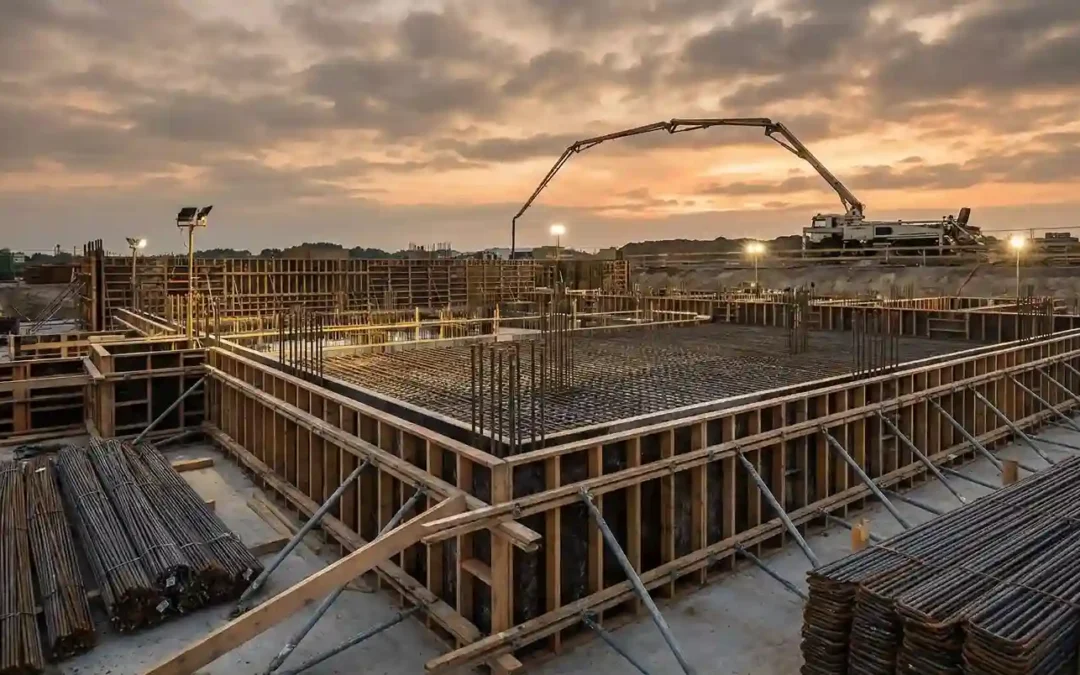
The construction industry is experiencing a major transformation, especially in the delivery of structural packages for large-scale projects. As structures reach new heights, deadlines become more pressing and demands increase. The separate tasks related to formwork, reinforcement, and concrete placement are shown to be less effective and riskier. This has caused a swift change across the industry towards cohesive FRP solutions, where a unified contractor oversees all three aspects—form, reo, and pour—in a coordinated contractor.
For developers, construction professionals, suppliers, and clients looking to execute large-scale projects, this integrated FRP approach has transitioned from an exclusive offering to the preferred delivery model. In this news, we go deeper into the reasons behind this shift, examine how integrated FRP contractors are transforming the structural landscape, and highlight how Future Form is at the centre of this movement with a cohesive, collaborative, and innovative approach.
The evolution of FRP contractors
Previously, the structural package was divided into three distinct subcontractors. One managed the formwork, another set up the reo, and another one managed the concrete pour. While this division previously functioned effectively within the industry, it has begun to show increasing problems as projects become more complex and deadlines tighten. Every subcontractor typically follows their own set of processes, priorities, and meanings of drawings, which can create gaps in communication and coordination.
In many countries, the development in the industry is shifting towards delivery models that aim to minimise fragmentation instead of enhancing it. This change comes from the understanding that numerous structural challenges develop not from a lack of expertise, but from misalignment among different teams. Integrated FRP contractors have become the answer—unifying form, reo, and pour under a single management, a cohesive programme, and a synchronised structural vision. The concept is simple: when a single team manages and understands the entire FRP process from beginning to end, results will improve. The industry is definitely paying attention.
Why the industry is shifting to integrated FRP solutions
As projects grow and so many deadlines, construction teams are recognising that the traditional segmented method for formwork, reinforcement, and pouring is no longer suitable to meet modern requirements. This explains why the industry is moving towards integrated FRP solutions.
1. Better communication across the structural package
One of the most common causes of delays and rework in construction is the absence of communication. When different companies manage form, reo, and pour, the information that spread takes place across multiple interactions, raising the chances of misinterpretation. A small error in formwork can delay the reinforcement process; these delays can push pouring schedules into overtime; and inconsistent pour timing can affect the overall programme.
Integrated FRP contractors improve communication by bringing it all together in one place. Rather than having various subcontractors share updates separately, a single cohesive team manages the complete flow of information. Changes are managed swiftly, sequencing is quickly updated, and design clarifications are handled without any delays. The improved communication is a key factor supporting the industry’s move towards integrated delivery.
2. Fewer errors and reduced rework
Rework has always been a major expense in construction. Many errors occur not because workers lack skill, but because teams operate with incomplete visibility of each other’s work. If the formwork contractor misunderstands reinforcement spacing, or if steel adjustments aren’t communicated properly to the pour crew, it can lead to costly errors later on.
Integrated FRP solutions address this by creating one team that understands every connection between every stage. When the same contractor is responsible for the entire FRP process, they have a comprehensive understanding of the structural package. They can anticipate design implications, detect clashes early, and resolve issues immediately. The outcome is cleaner, more precise work—and significantly less rework.
3. Faster cycle times and improved sequencing
Time plays a vital role in the industry of structural construction. When three contractors operate independently, delays develop and the sequencing frequently turns inefficient. A delay in reinforcement can stall the pour, or an adjustment in formwork require relocating steel once more, resulting in wasted hours or even days.
With integrated FRP contractors, sequencing becomes a collaborative effort rather than negotiation. The team controls every stage and can adjust workflows in real-time based on-site conditions. This usually leads to:
- Shorter floor cycles
- Faster project progression
- More predictable pour schedules
- Reduced downtime between stages
Faster doesn’t just mean quicker delivery—it also means fewer site risks, more predictable budgeting, and a smoother schedule for everyone involved.
4. Clearer accountability and consistent quality control
With separate subcontractors, accountability becomes blurred. If an issue arises, identifying who is responsible can slow down investigations and create conflicts. This can result in variations, delays, and in the worst cases, weakened structural integrity.
Integrated FRP contractors eliminate this uncertainty. One team is responsible for the entire structural package, ensuring a single standard of quality and one line of accountability. Every part of the structural system is overseen with the same level of detail, resulting in more consistent concrete finishes, improved reinforcement placement, and better formwork accuracy.
5. Cleaner sites and reduced waste
Fragmented teams tend to duplicate materials, equipment, and storage areas. This leads to more disorganised sites, greater waste, and inefficient logistics. Integrated FRP teams bring together resources, optimise storage solutions, and facilitate equipment sharing across all three disciplines.
This not only reduces material waste but also helps maintain:
- Safer work environments
- More organised staging areas
- Lower logistical costs
- Smoother movements throughout the project
Cleaner sites lead to safer teams—and safer teams deliver better outcomes.
Together, these benefits show why integrated FRP solutions are becoming the preferred structural delivery model for modern, fast-moving construction projects.
The structural advantages of having one unified FRP contractor
Integrated FRP solutions don’t just improve communication—they strengthen the basic structure. When form, reo, and concrete pour are overseen by one coordinated contractor, structural precision improves significantly.
Better structural accuracy
Integrated teams oversee tolerances throughout the entire FRP process, resulting in better alignment of columns and walls, more accurate reinforcement placement, higher-quality concrete finishes, and improved overall structural integrity.
Stronger collaboration with engineers
Design changes are a normal part of construction. Integrated FRP contractors respond to changes faster because they fully understand how each adjustment impacts the formwork, reinforcement, and pour plan. This creates quicker, and responsive workflows.
Enhanced use of digital tools
Integrated teams benefit more from digital engineering because they apply it across the entire FRP scope. Tools like digital pour sequencing, 3D models, and QA tracking systems become more accurate when used by one unified contractor.
Real-world demand: why FRP contractors are becoming essential
Across most countries, developers and builders are increasingly moving toward integrated FRP delivery because unified form, reo and pour teams consistently deliver smoother, more reliable outcomes. By implementing a unified structure for communication and scheduling, integrated FRP solutions effectively minimise delays, cut costs, and enhance quality control throughout the structural package.
This change has transformed integrated FRP contracting from an option into a standard expectation for major projects. With projects growing in complexity and deadlines becoming more pressing, clients increasingly prefer a single team to oversee the entire structural scope. This approach enhances accountability and improves predictability. Integrated FRP contractors have transitioned from being just an option to branding themselves as the new standard across the industry.
How Future Form delivers one coordinated structural vision
With the industry moving rapidly toward integrated FRP solutions, choosing a contractor that already operates with a unified structure has never been more important. At Future Form, integrated FRP delivery is not just an additional service; it is the standard of our technique. By bringing together the form, reo, and pour disciplines under a single operational framework, we provide structural packages that represent precision, transparency, and consistency.
A unified team working toward one vision
Our FRP contractors operate as one cohesive team, sharing the same programme, the same goals, and the same commitment to delivering high-quality outcomes. This reduces risk, minimises delays, and ensures the entire structure progresses as intended.
Streamlined sequencing and improved responsiveness
Future Form’s integrated approach enables immediate adjustments on site. Communication stays organised within a single team, enabling quick and efficient adjustments in sequencing without the delays that come from managing various subcontractors.
Cleaner, safer, and more efficient sites
Because Future Form manages all three stages—form, reo, and pour—we can plan logistics holistically, significantly reducing waste and keeping sites cleaner, safer, and more organised.
Reduced project risk from start to finish
Clients gain confidence knowing that only one contractor is responsible, quality remains consistent throughout the entire FRP process, clashes are identified early, and sequencing flows without disruption. This simplifies delivery, strengthens accountability, and improves overall structural results.
The future of integrated FRP contractor
The trend towards integrated FRP delivery is going to grow stronger as structural packages evolve in complexity and project demands keep rising. Many developers today understand that uniting form, reo, and pour under a single coordinated contractor leads to improved communication, streamlined sequencing, and more reliable structural results. As the need for precision, efficiency, and minimised rework continues to grow, integrated FRP contractors are set to become pivotal in the delivery of major projects.
As the construction industry develops, integrated FRP solutions will impact digital engineering practices will impact quality assurance systems, and refine overall project planning. Future success will belong to projects that utilise cohesive teams, efficient workflows, and a broad perspective on the entire FRP lifecycle. Future Form is dedicated to leading this project by bringing together our team, our programme, and our structural vision for every development.
Ready to deliver faster, cleaner, and more coordinated outcomes? Partner with Future Form and experience the power of a truly integrated FRP solution.
References
Concrete Institute. (2021). Best practice guidelines for concrete structures. Concrete Institute of Australia. Retrieved from: https://concreteinstitute.com.au/
Ghosh, S., & Tran, P. (2020). Integrated construction delivery models and their impact on project efficiency. Journal of Construction Engineering and Management, 146(7), 1–12. Retrieved from: https://ascelibrary.org/journal/jcemd4
Hanna, A. S., & Ibrahim, M. (2017). Impact of rework on construction cost performance. Construction Management and Economics, 35(7), 386–397. Retrieved from: https://www.tandfonline.com/toc/rcme20/current
O’Brien, J., & Plotnick, F. (2020). Construction planning and scheduling (5th ed.). Pearson. Retrieved from: https://www.pearson.com/
Tam, V. W., Fung, I. W., & Sing, M. C. (2021). Waste reduction in structural concrete works: A systems-based approach. Resources, Conservation and Recycling, 169, 105508. Retrieved from: https://www.sciencedirect.com/journal/resources-conservation-and-recycling





